Many times people confuse non-poisionous snakes with poisionous snakes. The Tips written in this article were written to help clear the confusion and to help save the lives of snakes, people and pets through proper identification and safety precautions.
At Highfeather Ranch, Tom Wyant from the Wildlife Center, demonstrated snake handling and showed live species of Non-Poisionous Snakes: Garter Snakes, a Mountain Patch Nose Snake, a Milk Snake, a Red Racer, 3 varieties of Corn Snakes, a Hognose Snake and a Bull Snake. He also showed 3 species of venomous Rattlesnakes; the Western Diamondback, a Prairie Rattler and a Black Tail Rattlesnake. Tom also brought along a poisionous lizard - a Gila Monster. Tom travels to various Northern New Mexico schools, summer camps and other places to present programs on snake awareness upon request.
Tom stressed safety and the immediate need for medical help if bit by a pit viper bites (aka snakes with fangs - Rattlesnakes), Coral Snakes and Gila Monsters (lizards with teeth) which can be deadly.
All snakes are beneficial to the environment as they cut down on the rodent population. Of the 46 snake species found in New Mexico, only 8 are poisonous and potentially dangerous. This includes 7 species of Rattlesnakes and the Coral snake. A bite from a Gila Monster Lizard is also poisionous. Tom identified the the 7 species of Venomous Rattlensnakes as: the Prairie Rattler, Western Diamondback, Black Tailed Diamondback, Rock, Mojave, Ridgenose and the Massasauga - aka the Western Pygmy snake which is the most dangerous snake in the US. Snakes may bite if threatened. If you get bit - it helps to know what type of snake it was for the proper treatment.
NOTE: Many hospitals do not stock or may not have the correct anti-venom for your type of snake bite. Some poisonous snakes have neurological or muscular deterioration venoms others have serums. Anti-venom also has a "shelf life." Be sure your doctor checks the date and works with the "Poision Control Center" to give you the correct treatment.
Many of the snakes Tom talked about are pictured below. See the Reference section for additional info and use Google to research info on for those not pictured. You can double-click on the slideshows to enlarge photos for fullscreen viewing.
ACTIVITY
Snakes emerge from their dens in May and return to them in October. July and August are mating months and their most active and aggressive time of the year. This is also when the most snake bites occur. The ideal temperature for snakes is 70 Degree weather when they can move fast to hunt. Many snakes hunt at night, early morning and late afternoon. Snakes are more sluggish and move slower in 60 Degree weather or below.
At Highfeather Ranch, Tom Wyant from the Wildlife Center, demonstrated snake handling and showed live species of Non-Poisionous Snakes: Garter Snakes, a Mountain Patch Nose Snake, a Milk Snake, a Red Racer, 3 varieties of Corn Snakes, a Hognose Snake and a Bull Snake. He also showed 3 species of venomous Rattlesnakes; the Western Diamondback, a Prairie Rattler and a Black Tail Rattlesnake. Tom also brought along a poisionous lizard - a Gila Monster. Tom travels to various Northern New Mexico schools, summer camps and other places to present programs on snake awareness upon request.
Tom stressed safety and the immediate need for medical help if bit by a pit viper bites (aka snakes with fangs - Rattlesnakes), Coral Snakes and Gila Monsters (lizards with teeth) which can be deadly.
All snakes are beneficial to the environment as they cut down on the rodent population. Of the 46 snake species found in New Mexico, only 8 are poisonous and potentially dangerous. This includes 7 species of Rattlesnakes and the Coral snake. A bite from a Gila Monster Lizard is also poisionous. Tom identified the the 7 species of Venomous Rattlensnakes as: the Prairie Rattler, Western Diamondback, Black Tailed Diamondback, Rock, Mojave, Ridgenose and the Massasauga - aka the Western Pygmy snake which is the most dangerous snake in the US. Snakes may bite if threatened. If you get bit - it helps to know what type of snake it was for the proper treatment.
NOTE: Many hospitals do not stock or may not have the correct anti-venom for your type of snake bite. Some poisonous snakes have neurological or muscular deterioration venoms others have serums. Anti-venom also has a "shelf life." Be sure your doctor checks the date and works with the "Poision Control Center" to give you the correct treatment.
Many of the snakes Tom talked about are pictured below. See the Reference section for additional info and use Google to research info on for those not pictured. You can double-click on the slideshows to enlarge photos for fullscreen viewing.
ACTIVITY
Snakes emerge from their dens in May and return to them in October. July and August are mating months and their most active and aggressive time of the year. This is also when the most snake bites occur. The ideal temperature for snakes is 70 Degree weather when they can move fast to hunt. Many snakes hunt at night, early morning and late afternoon. Snakes are more sluggish and move slower in 60 Degree weather or below.
TIP 1 - Non-Poisionous Snakes have "Pointed Tails" - Venomous Snakes have "blunt or rounded" tails.

Note the "Pointed Tail" on this "non-poisionous" Bull Snake.
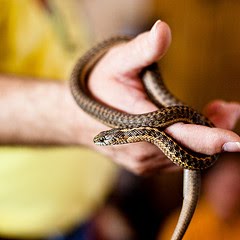
Garter Snake
Garter Snakes are Not Poisionous snakes.
There are nocturnal and diurnal varieties of Garter Snakes. Nocturnal snakes have scales that glisten. Diurnal snake scales do not have rough scales that do not glisten. Their rough scales protect them from daytime predators.
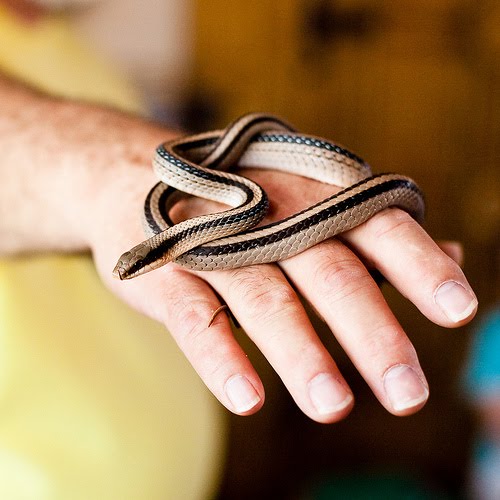
A Patchnose Snake Tom named "Patches"
Milk Snake or Coral Snake?
Milk Snakes and Coral Snakes are often confused because of the similarities and the "order" of colors of their banded markings. The Milk Snake in the slideshow below is a non-poisonous snake. The order of its colors are different from a Coral Snake's colors. The order of a Milk Snake's banded colors are: red, black and yellow, whereas, the order of a Coral Snake's banded colors are red, yellow and black.
TIP 2 - To identify a Coral Snake remember the slogan,
"Red next to Yellow can Kill a Fellow."
..
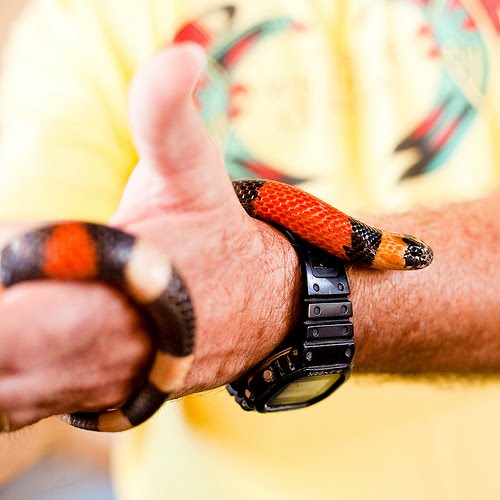
Milk Snakes are non-poisionous snakes. Note how this Milk Snake's colors are seperated by black bands. A Coral snake is a poisionous snake. The colors red and yellow are "next" to one another.
..

The Western Coral Snake pictured above is a Poisionsous Snake. They are native to southern New Mexico and Arizona. This photo demonstrates the slogan; "Red next to Yellow will Kill a Fellow."
Coral Snakes are highly poisionous snakes and should not be handled. A bite from one requires immediate hospital treatment.
Hognose snakes are the "great pretenders". They are famous for their anti-predator defense of flipping onto the back to play dead, tongue lolling, and spitting blood. If turned upright, they'll flip back over, to play dead. Captive snakes rarely exhibit this behavior. The will also mimic venomous snakes. They will flatten the neck into a cobralike "hood", hiss and strike (closed mouthed) and rattle their tail if startled.
Hognose Snakes are rear-fanged venomous snakes. They are semi-venomous snakes that are not considered to pose an immediate danger to humans. However, some people do have allergic reactions to this type of snake bite and others are not affected at all. People react differently to snake bites based upon their age and health. It would be a good idea to have a doctor look at the bite. Snake bites can turn into infections.
Here's a link to an article that discusses this in more depth.
http://www.hognose.com/pages/venomous.htm
The Western Hognose Snake has a funny (upturned) nose or snout that they use for digging. These snakes average between 36 – 48 inches long, their bodies are chunky, and much heavier than most other snakes of comparable length.
..
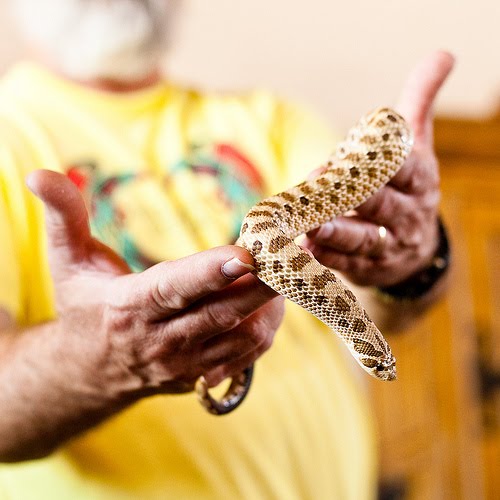
Tom's Hognose Snake named "Miss Piggy"
Corn Snake
Corn snakes eat rhodents and birds and are often found near Corn fields. Tom showed us the Corn Snake below along with the 2 other Corn Snakes: the albino Snow Corn Snake and the Native New Mexican Corn Snake. (Not pictured is the Ghost Corn Snake a completely white corn snake.)
Because of a genetic mutation the blizzard (or ghost) corn and the snow corn are white with red eyes. They are missing both the orange and black pigments. The snow corn has a little more apparent pattern giving it a snowflake appearance. The blizzard corn is very plain and white!
Because of a genetic mutation the blizzard (or ghost) corn and the snow corn are white with red eyes. They are missing both the orange and black pigments. The snow corn has a little more apparent pattern giving it a snowflake appearance. The blizzard corn is very plain and white!
Snow Corn Snake
New Mexican Native Corn Snake
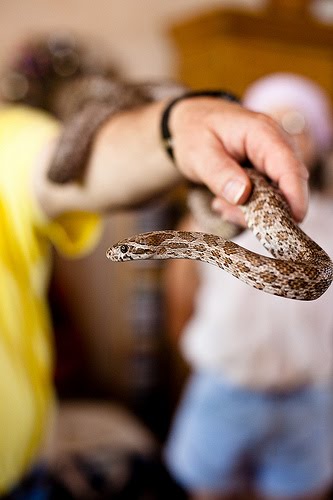
New Mexico Native Corn Snake
..
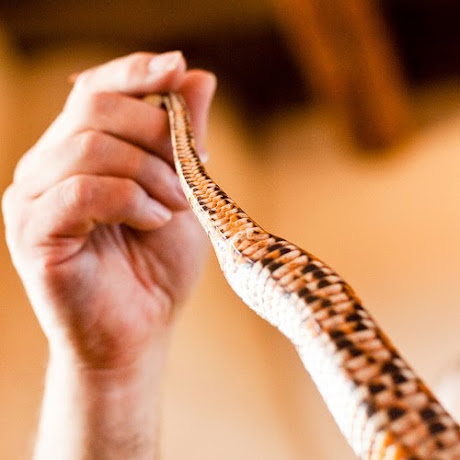
Corn Snake with Lateral scales on belly and Bi-lateral scales on tail.
TIP 3 - Non-Poisonous snakes, such as, this Corn snake, can be identified by the lateral plates on it's belly. The lateral plates on the belly turn into bi-lateral plates at the base of the tail and extend to the tip of it's “Pointed Tail." Venomous snake's bellies only have lateral plates that extend the entire length of their bellies to the end of their "Rounded Tails."
This Red Racer is also called a Coach Whip because of its tail. They come in a variety of colors and are known for their speed. These are beneficial snakes. Part of their diet includes eating other snakes and Rattlesnakes.
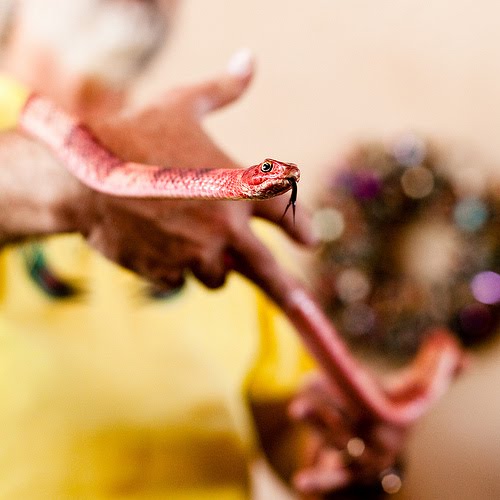
Snakes smell their environment by flicking their tongues.
..

A Red Racer Western Coach Whip.
Bull Snake
Tom with his Bull snake is pictured above.
Some non-poisonous snakes, such as, bull snakes, the red racer or coach-whips, and rat snakes (Corn Snakes) , behave like rattlesnakes when confronted. This behavior may include hissing loudly or vibrating the tail. If the tail is in contact with dry leaves or grass, these snakes may be mistaken for rattlesnakes.
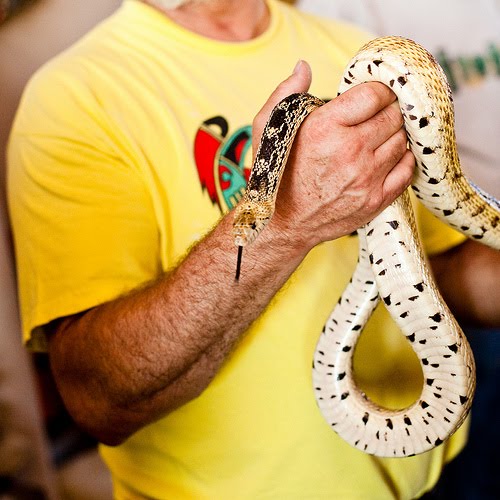
In the photo above Tom gently holds a Bull Snake
The Western Diamondback Rattlesnake above, "Bruiser," is over 17 years old. Rattlesnakes can live up to 30 years old. New Mexico has 7 species of rattlesnakes; the Prairie Rattler, Western Diamondback, Black Tailed Diamondback, Rock, Mojave, Ridgenose and the Massasauga - aka the Western Pygmy snake. These snakes vary in size, color, and other characteristics. The color of a rattlesnake’s scales often match its environment. They can be brown, gray, green, red, pink, or yellow.
TIP 4 - Rattlesnake Identification
Newly born rattlesnakes do not have rattles like older rattlesnakes do. Most rattlesnakes have "triangular shaped” heads with the exception of the Pygmie Rattler (aka the Mojave Green) which has a round head. Most rattlesnakes have clearly defined diamond patterned skins and will rattle their tail as a warning when threatened. Rattlesnakes have lateral scales on their bellies which run from head to tail.
Use this link to see a photo of the lateral scales and a video of "Bruiser" to hear how his rattles sound. http://www.flickr.com/photos/ybron/with/3804979936/
Rattlesnakes have heat sensing areas known as the pit on each side of the head. The pit looks somewhat like a nostril and helps the snake see warm-bodied food. The pit is located about midway between and slightly below the eye and nostril.
AGE
Some species of Rattlesnakes can live up to 30 years. You can’t tell the age of a rattlesnake by the number of buttons on its (rattle) tail. Snakes shed their skin several times a year depending up on how good their diet is. If their diet has been good they can produce many buttons per year.
A baby rattle snake has a pre-button 1 week after its born before shedding his first skin. If their diet is good they can shed their skin up to 4x a year (or more) and produce several buttons (6+) during their first year of growth. Baby rattlesnakes are more dangerous than older rattlesnakes because they do not know how to control their venom when stirking. A bite from a baby rattler can be deadly.
Rattlesnakes love to hunt at night, early am, and late afternoon. They cannot be in direct sun over 30 minutes or they will die. King Snakes and Coach Whip Snakes (non-poisionous snakes) eat Rattlesnakes. Roadrunners are also natural predators of rattlesnakes.
To see courtship rituals, mating and hunting take a look at this video.
http://www.babelgum.com/browser.php#play/SEARCH_SIMILAR,clipID:3016378,includeClip:true,order:MOST_RELEVANT/0,3016378
Rattlesnakes must be relocated under 5 miles or they cannot survive. You can contact Tom to help you relocate any type of snake. Home: 505/672-1981 Cell 505/412-1984
Tip 5 - Never pick up a dead snake or the head of a severed snake. You can still be bitten several hours after a snake's death. Snakes will also play dead and many bites are caused by people picking up seemingly dead snakes.
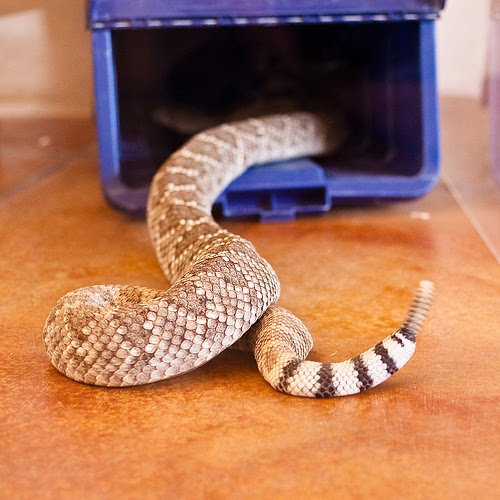
"Bruiser" is a male Western Diamondback Rattlesnake, aka as a Coon rattler due its tail. You can't tell tell the age of this Rattlesnake by the rings (not buttons) on his tail. Five rings or more are male. Less that 5 rings is female.
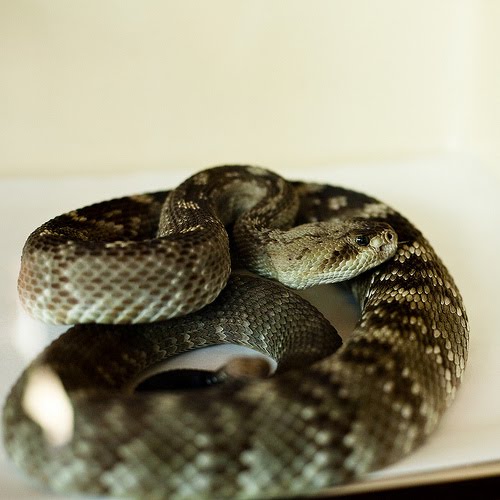
Note how this Black-Tailed Rattlesnake's pattern on his back is less defined than the Western Diamondback Rattlesnake's pattern. The tail is also completely black.
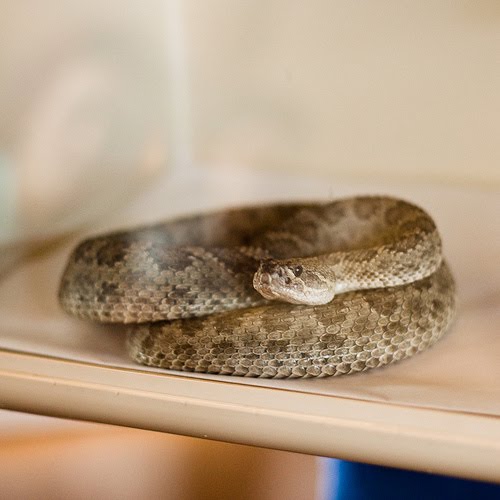
Western Prairie Rattlensnake - does not have diamond shaped pattern on it's back.
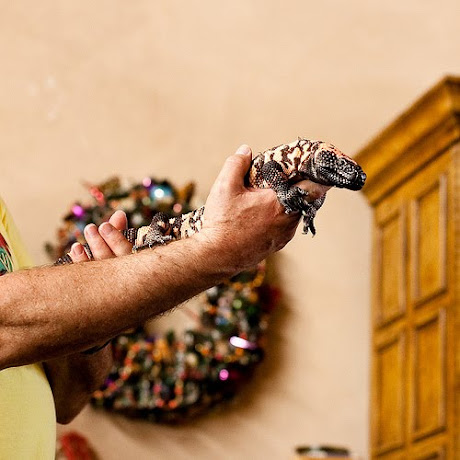
Gila Monsters are poisionous lizards and medical treatment is required. A Gila monster bite is painful to humans. They have very sharp teeth and will hang on to prey to inject it's venom. They are an endangered species and $10,000 fine or 10 years in jail is imposed on those caught possessing Gila Monsters.
THANK YOU!
A Very Special Thanks to...
Tom Wyant who volunteers at the Wildlife Center and an avid snake enthusiast who teaches programs about Snake Awareness and Identification in Northern New Mexico. Tom talks about how beneficial snakes are to the environment, clears up misconceptions and talks about snake handling, snake bites and Safety. Tom travels to various locations and schools to present his program. Tom will also safely remove snakes from areas and will adopt unwanted snake pets in Taos, Santa Fe, Espanola, Los Alamos and surrounding areas.
If you need help with snakes or want to schedule an educational program with Tom he can be reached at 505/672-1981 or 505/412-1984. http://www.thewildlifecenter.org/visit.html
Marianna Hatten, Owner of High Feather Ranch B&B, http://www.highfeatherranch-bnb.com/ , who graciously offered her Inn for this educational program to the local community.
Cindy Roper, a caring environmentalist, who arranged Tom's lecture and invited the local community to attend.
Annie Whitney for her constant diligence in overseeing the Breakfast Club alias and keeping us informed about important events.
Peter Norby Photgraphy for his photos.
http://www.flickr.com/photos/ybron/sets/72157621835359211/
Doug Patrick for his photos.
Colleen McCann for her photos and creation of this blogspot.
DISCLAIMER: The information in this blogspot is not conclusive and was created as a general resource. Information may not be 100% accurate. It's encouraged to contact professionals in the field to verify information for accuracy.